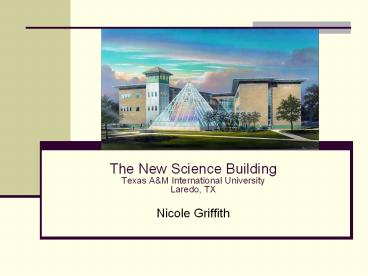The New Science Building Texas A - PowerPoint PPT Presentation
Title:
The New Science Building Texas A
Description:
The New Science Building Texas A&M International University Laredo, TX Nicole Griffith – PowerPoint PPT presentation
Number of Views:77
Avg rating:3.0/5.0
Title: The New Science Building Texas A
1
- The New Science BuildingTexas AM International
UniversityLaredo, TX - Nicole Griffith
2
The New Science Building
- 3 Story Cast-in-Place Concrete Structure
- 80,000 S.F.
- Estimated Cost of 18 Million
- Houses Science Labs, Classrooms, Offices
- Features a Planetarium and the Deans Office
Tower
3
The New Science Building
- Owner Texas AM University System
- General Contractor Constructors Associates,
Inc. - San Antonio, TX
- Construction Began June 2003
- Main Building Completed December 2004
- Planetarium Complete May 2005 by Owner
4
Thesis Overview
- 4D Modeling
- Structural and Construction Feasibility Review of
the Planetarium Concrete
5
CM Depth
- 4D Modeling
6
Reasons for Using 4D Modeling
- Complicated Schedule Setup Makes Sequencing and
Level of Detail Difficult to Maintain - Unique Structure of the Planetarium Can Make
Visualizing the Construction Process Difficult - 4D Modeling is a Key Technology Vitally Important
to the Construction Industry
7
4D Modeling
- Create 3D Model of the Structure Using Autodesk
Revit 7.0 - Export into AutoCAD 2004 format
- Export into Common Point 4D
- Link to Structure Schedule
8
4D Modeling
- Revit is a Parametric Modeling Tool
- Model using Building Components
- Unique Structures, Such as the Planetarium, can
be Difficult to Represent - Must be Exported into AutoCAD First in Order to
Export into Common Point - Looses Detail, Difficult to Control Layers
9
Revit Model
10
AutoCAD Model
11
Common Point 4D Model
12
Results
- Multiple Sequencing and Level of Detail Errors
Discovered in the Structure Schedule - Using a 4D Model Could Have Eliminated Problems
that Resulted Due to Confusion from the
Construction Schedule
13
Sequencing Error
14
Inconsistent Sequence
15
Sequencing Error
16
Sequencing Error
17
CM Depth/Structural Breadth
- Structural and Construction Feasibility Review of
the Planetarium Concrete Structure
18
The Planetarium
19
Planetarium Concrete
- Architectural Concrete Structural Base
- As-Cast Smooth Finish
- No Further Finishing After Formwork Removal
- Plastic-Laminated Plywood Formwork
- Result was Unacceptable to the Owner
- Variations in Color
- Inconsistent Texture
- Surface Imperfections (Lift Lines, Air Pockets)
- Visible Formwork Joints
20
Planetarium Concrete
- Investigate Both the Project Specifications as
well as Standard ACI Specifications - Look for Inconsistencies, Areas for Concern
- Review and Suggest Alternate Formwork
- Review and Suggest Alternate Concrete Mix
Design/Specifications - Review and Suggest Alternate Concrete Placement
Methods
21
Standard Specifications
- Perform Slump Tests on Trial Batches at Highest
Lowest Expected Ambient Temperatures - Not Specified or Performed for Project
- Poured in mid-July Creates Cause for Concern
22
Project Specifications
- No Fly Ash
- No Form Ties
- Mock-Ups Pre-Installation Meetings
- Not Implemented Due to Time Constraints
- Small Samples Submitted Instead
- Well-Sealed Formwork Joints
- Not Properly Constructed
23
Formwork
- Conventional Forms
- Most Economical for This Type of Project
- Simple, but Proper Construction is Important
- Non-Reactive Form Release and Other Agents
- Smooth Finish is Not Optimal for Appearance
- Elevates Visibility of Surface Defects
24
Formwork
25
Resulting Recommendations
- Use Plywood Formwork with a Textured Plastic
Liner - Use a Non-Reactive Form Release Agent That Will
Not Affect the Appearance of the Concrete Finish
26
Resulting Recommendations
- Consider the Use of Fly Ash in the Design of the
Architectural Concrete - Fly Ash Contains Properties That May Help Resolve
the Problems Encountered - Be Sure That Any Additives, Such as Water
Reducing Agents and Curing Compounds, Will Not
Alter the Finished Appearance of the Concrete
27
Resulting Recommendations
- Maintain Similar Temperatures for Concrete,
Rebar, Formwork, and Any Other Affected Materials
at all Times When Concrete is Being Poured to
Eliminate Color and Texture Variations and Lift
Lines
28
Resulting Recommendations
- Provide a Large-Mass Mockup of the Architectural
Concrete Using Same Materials and Methods of
Placement to Ensure the Quality of the Final
Product - Be Sure to Pour the Concrete for the Mockup at
the Same Temperature as is Expected for the
Actual Pour
29
Resulting Recommendations
- Coordinate all Interested Parties, Particularly
the Concrete Contractor and Steel Erector, Before
the Production of Shop Drawings, to Ensure That
All Parties Are Aware of Others Requirements for
Construction so that Delays and Additional Costs
Can be Avoided
30
Conclusions
- Use a 4D Model to Eliminate Problems That May
Result Due to Confusion from the Construction
Schedule, Sequencing, and Level of Detail Errors - Reconsider the Concrete Mix Design, Formwork
Type, and Placement Requirements of the
Planetarium Architectural Concrete in Order to
Achieve the Desired Finish
31
Questions?
32
Acoustical Breadth
- Planetarium Acoustical Analysis
33
Acoustical Analysis
- Owners Representative Had Concerns Regarding the
Acoustical Quality of the Planetarium - The Planetarium Space Itself
- The Effect of Mechanical Room Noise Adjacent to
the Planetarium Space
34
Reverberation Time
- Performed on Planetarium Space
- Results Were Acceptable 0.95 s _at_ 500 Hz
- Acoustical Quality Was Much Poorer During
Construction
35
STC Calculation
- Performed for the Mechanical Room Walls
- Result Was STC Rating of 42 Acceptable
- Well-Constructed Insulated Walls































